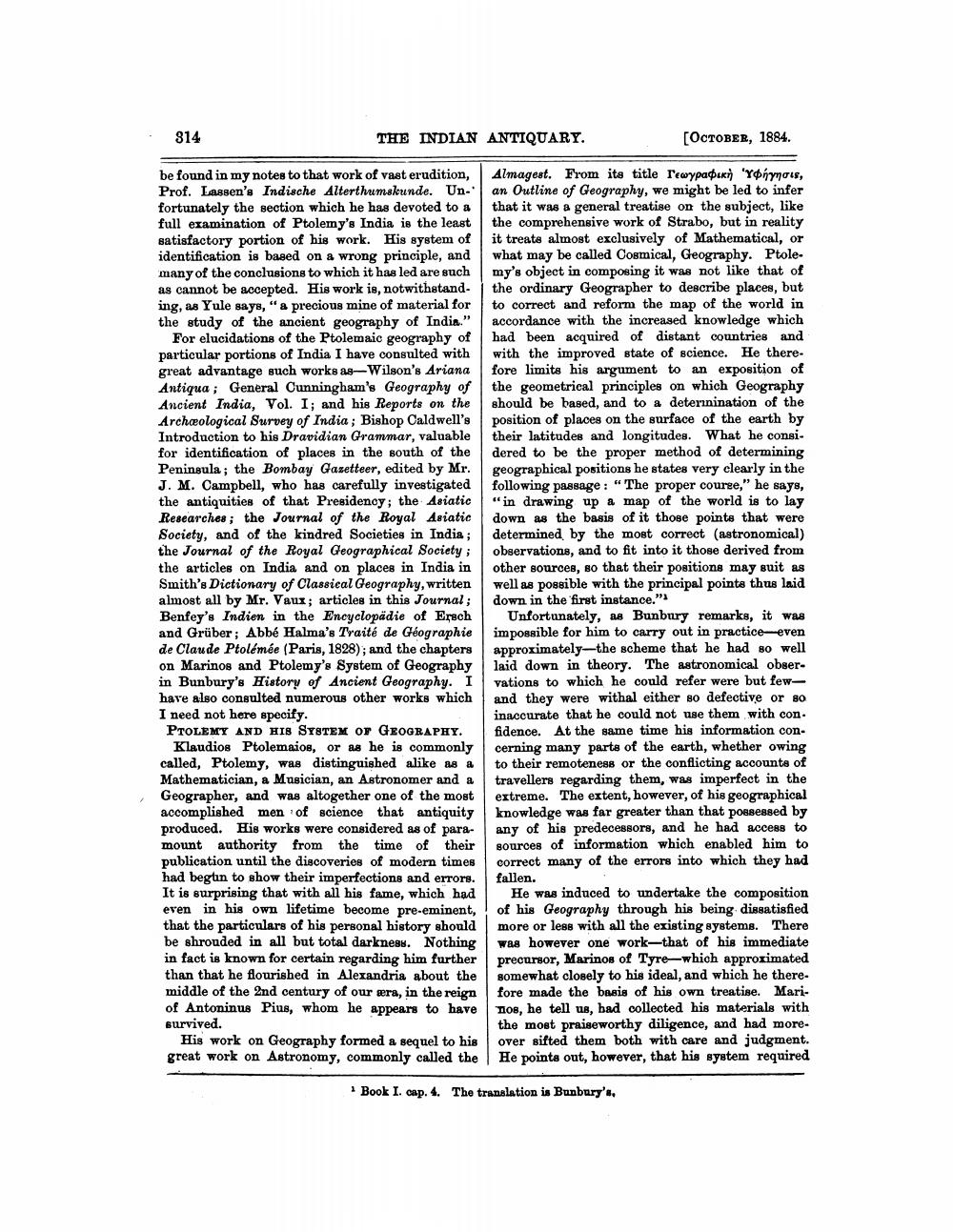________________
•
314
THE INDIAN ANTIQUARY.
[OCTOBER, 1884.
be found in my notes to that work of vast erudition, Prof. Lassen's Indische Alterthumskunde. Un fortunately the section which he has devoted to a full examination of Ptolemy's India is the least satisfactory portion of his work. His system of identification is based on a wrong principle, and many of the conclusions to which it has led are such as cannot be accepted. His work is, notwithstanding, as Yule says, " a precious mine of material for the study of the ancient geography of India."
For elucidations of the Ptolemaic geography of particular portions of India I have consulted with great advantage such works as-Wilson's Ariana Antiqua ; General Cunningham's Geography of Ancient India, Vol. I; and his Reports on the Archæological Survey of India; Bishop Caldwell's Introduction to his Dravidian Grammar, valuable for identification of places in the south of the Peninsula; the Bombay Gazetteer, edited by Mr. J. M. Campbell, who has carefully investigated the antiquities of that Presidency; the Asiatic Researches; the Journal of the Royal Asiatic Society, and of the kindred Societies in India; the Journal of the Royal Geographical Society; the articles on India and on places in India in Smith's Dictionary of Classical Geography, written almost all by Mr. Vaux; articles in this Journal; Benfey's Indien in the Encyclopädie of Ersch and Grüber; Abbé Halma's Traité de Géographie de Claude Ptolémée (Paris, 1828); and the chapters on Marinos and Ptolemy's System of Geography in Bunbury's History of Ancient Geography. I have also consulted numerous other works which I need not here specify. PTOLEMY AND HIS SYSTEM OF GEOGRAPHY.
Klaudios Ptolemaios, or as he is commonly called, Ptolemy, was distinguished alike as a Mathematician, a Musician, an Astronomer and a Geographer, and was altogether one of the most accomplished men of science that antiquity produced. His works were considered as of paramount authority from the time of their publication until the discoveries of modern times had begin to show their imperfections and errors. It is surprising that with all his fame, which had even in his own lifetime become pre-eminent, that the particulars of his personal history should be shrouded in all but total darkness. Nothing in fact is known for certain regarding him further than that he flourished in Alexandria about the middle of the 2nd century of our æra, in the reign of Antoninus Pius, whom he appears to have survived.
His work on Geography formed a sequel to his great work on Astronomy, commonly called the
Almagest. From its title lewypapu) 'Yohyois, an Outline of Geography, we might be led to infer that it was a general treatise on the subject, like the comprehensive work of Strabo, but in reality it treats almost exclusively of Mathematical, or what may be called Cosmical, Geography. Ptole. my's object in composing it was not like that of the ordinary Geographer to describe places, but to correct and reform the map of the world in accordance with the increased knowledge which had been acquired of distant countries and with the improved state of science. He therefore limits his argument to an exposition of the geometrical principles on which Geography should be based, and to a deterinination of the position of places on the surface of the earth by their latitudes and longitudes. What he consi. dered to be the proper method of determining geographical positions he states very clearly in the following passage: "The proper course," he says, "in drawing up a map of the world is to lay down as the basis of it those points that were determined by the most correct (astronomical) observations, and to fit into it those derived from other sources, so that their positions may suit as well as possible with the principal points thus laid down in the first instance."
Unfortunately, as Bunbury remarks, it was impossible for him to carry out in practice-even approximately-the scheme that he had so well laid down in theory. The astronomical observations to which he could refer were but fewand they were withal either so defective or so inaccurate that he could not use them with con. fidence. At the same time his information concerning many parts of the earth, whether owing to their remoteness or the conflicting accounts of travellers regarding them, was imperfect in the extreme. The extent, however, of his geographical knowledge was far greater than that possessed by any of his predecessors, and he had access to sources of information which enabled him to correct many of the errors into which they had fallen.
He was induced to undertake the composition of his Geography through his being dissatisfied more or less with all the existing systems. There was however one work—that of his immediate precursor, Marinos of Tyre-which approximated somewhat closely to his ideal, and which he therefore made the basis of his own treatise. MariTos, he tell us, had collected his materials with the most praiseworthy diligence, and had moreover sifted them both with care and judgment. He points out, however, that his system required
Book I. cap. 4. The translation is Bunbury's,




